Augieland
Rants about food and other stuff, but mostly food.
Categories
- ? (5)
- Baguette Quest (8)
- become a regular (9)
- Books (2)
- Current Affairs (37)
- day drinking (1)
- Food & Wine Magazine Aspen Classic (6)
- friendly spirits (4)
- Italy (3)
- learn wine (33)
- rants (41)
- recipe (20)
- restaurants (143)
- Spain (6)
- the best (10)
- Today in the Times (7)
- Truffles (9)
- wine tasting (7)
blogs that involve food
Search Augieland
restaurant reports
November 27, 2006
November 21, 2006
Thanksgiving Wine
Wine with Thanksgiving dinner seems well discussed these days. Personally, for an all around suggestion when asked I tend to recommend Dr. Konstantin Frank’s Salmon Run Riesling.
There are three levels to the classic Thanksgiving dinner as far as a see it. The first are the immutable dishes that absolutely must be included no matter what else you do: roasted turkey, gravy, horrible canned cranberry jelly (other versions are great but nothing has the insane acidity combined with sweetness of the can-shaped blob), stuffing (which varies regionally), and fluffy white mashed potatoes. In the second level are the standards that round out this meal and are interchangeable but will appear in variations: sweet potatoes (roasted with glaze or mashed and topped with marshmallow), green beans (almandine, baked with onion crisps, steamed), creamed pearl onions, green salad, and way too many other ingredients and preparations to go on listing. The third level is one I heartily endorse as long as it does not attempt to replace any of the core five components; it is comprised of the foodie items. Here is where truffle whipped potatoes will show, great in addition to mashed but not a good substitute. Orange-glazed grilled acorn squash can sit right next to sweet potato purée or replace it, but must sit proudly next to the simple, straightforward traditional roast turkey dinner. In my opinion, you can fancy yourself a foodie all you like and try new things with your family and strive to impress, but to impress me make a better turkey than I have ever had; perfect the flavors, don’t replace them.
Over the years I have tried many wine parings to this traditional meal. I have had the very American and egocentric “if I like drinking it, I will like food with it” dinner in which mostly Bordeaux was served. We did the all rosé dinner and the champagne/rosé champagne dinner. I’ve been to the “only vitis grape indigenous to America is Zinfandel” dinner (really indigenous to Croatia by the way), and have tried the always-a-failure “Beaujolais Nouveau with turkey” dinner. In the long run, I have come to feel that the best parings are aromatic whites: they handle the tartness of cranberries, the richness of mashed potatoes, draw out the subtlety of well roasted turkey and stuffing, and stand the best chance of pairing with the thousands of other dishes that will appear over the years.
Having been through all the Alsatian versions, the German versions, the Austrians and the Americans, I have a couple of standbys: Austrian Grüner Veltliner is quite good; in France go with Pinot Gris or Blanc; and in Germany go with the earliest of the Rieslings, Kabinette or Spatlese. As far as America goes, I wanted it to be the home of the perfect wine for the American holiday but had found most of the aromatic whites of America to be overwrought and/or cloying. Then I tried Salmon Run and the other Rieslings of the Finger Lakes region.
Salmon Run is the second label of Dr. Konstantin Frank, the man credited with bringing viticulture to the Finger Lakes. His is a fascinating story well worth learning, but has little to do with pairing wine to turkey. His wine though is my favorite for gifting, bringing, suggesting, and drinking (at least till the crowd forces the move to red) for Thanksgiving dinner.
Autumnal by nature, dry Riesling is pretty well suited to the Thanksgiving meal. Salmon Run benefits from being local – American if that’s you, and New York for me. I have sampled the current vintages over the last five years and have found them, in spite of vintage variation, to be light, minerally and steely, with driving acids enough to contrast well while having enough autumnal fruit and spices on the nose to compliment. And best of all, since a reasonable amount of any one wine for my family gatherings is at least a case, it is very fairly priced ($12.99 on the website).
Start the way I did, add one bottle to that collection of under twenties we all end up mixing into a case with bright ideas like California Sangiovese and see how it suits you.
10:25 AM in learn wine, rants, the best | Permalink | Comments (0)
November 10, 2006
Thoughts week ending 11/10/06
… I just assume diners know that real Kobe is back in America after a hiatus. But Meg recently linked this rather fluffy piece in the Post so I figured I would offer my experience with it here. I became aware of the embargo’s end shortly before I had what I assumed was real Kobe on my second L’Atelier visit. I didn’t ask so I can’t swear it was authentic, what I can say is it was exponentially better than all the other meat I have been served around town that was branded as Kobe or Waygu (don’t know if you have been to Old Homestead but little in New York food is as pathetic as their offerings).
When I had this discussion with my friend Mark, the Chef De Cuisine at Morimoto, he explained that to truly appreciate the finest Kobe it should be prepared Shabu Shabu. In a nutshell, you quickly swish very thinly sliced Kobe through a hot, flavored liquid and pair it to differing vegetables and dipping sauces. Absolutely convinced that Mark had gone insane from too much Japanese exposure and that meat with that kind of fat content could not be better boiled than seared, I accepted his challenge, leading to my first ever full meal at Morimoto not at the Omakase bar.
The meal left me feeling three things: that Mark is a very good chef producing very cool food from the Morimoto kitchen, that I am a bad friend for confining my dining at his restaurant to the Omakase bar with which he is not involved, and that I was totally wrong – Shabu Shabu is indeed the superior manner for Kobe preparation.
Grilled/seared/roasted and all other high heat methods scorch the predominant and flavorful fats, while with Shabu Shabu the flavored broth heated by an incredibly hot rock releases and encourages them to bloom, offering more of a slightly melted silky texture. Words like rich, buttery, and unctuous describe fast high heat preparations of Kobe and they are indeed special. However, I have no words to describe the sensation of this dish. I will tell you it ended a headache that I had in my temples and I spent most of the rest of the evening with the aromas running through my head in rather blissful contemplation.
There are many reasons to be into trying Kobe and it is an amazing ingredient. If your inspiration is that you are into flavor contemplation and you have an opportunity to try it as Shabu Shabu I think it is well worth taking.
Not sure why I never posted a report on the meal; maybe because I didn’t keep good enough notes, or didn’t want to concede my wrongness to Mark. Either way it was an exceptional meal. I did shoot it, though. Here are the pics of the Kobe Shabu Shabu course:


09:05 PM in ?, rants, restaurants, the best | Permalink | Comments (0)
November 03, 2006
Thoughts week ending 11/03/06
…Because I see it as such a simple reality that the trans-fat ban is stupid and will in the long run hurt the cause of American health more than help I haven’t really paid attention to it much, but this article in the Motley Fool has forced my hand. To learn the lesson of why a trans-fat ban is stupid you need look no further than the origins of the problem.
At some point some genius decided that butter (a component of the human diet for a very long time) was bad for you and said we shouldn’t eat it, giving the American population the belief that butter = bad. Then some other genius invented a way to make non-animal products behave and seem somewhat like animal products, and for some reason believed and got others to believe that a substance with zero equivalents in nature was better nutrition for humans than milk that had been stirred a lot. Americans got the message that margarine was fine and began consuming more of it than they ever did butter. Later, the truth that science does not make better food but alternate food became obvious, and the fact that the created food item was bad for you was probably also apparent but not necessarily admitted to.
So now here we are. Turns out the alternate food is basically poison to some degree or other, but rather than learn from past mistakes and put energy into teaching Americans the nature of fats and that natural fats used appropriately are far better for you than any other possible substitute, big business has created a new food, this time from a plant they created that has a resistance to poison added to its genetic make up, and Americans are getting the message that fried chicken at KFC is not as bad for you as it used to be.
Rather than go back to the naturally occurring lipids that were doing little if any harm originally, the solution is a new synthetic food. The article notes:
"In an interesting aside, the company that provides the Vistive brand of low-linolenic soybeans is none other than biotech giant Monsanto (NYSE: MON). Monsanto put out a press release applauding KFC's move, while KFC said it is working with several possible suppliers, including Monsanto, to secure its oil. Known for genetically modified agricultural products, Monsanto says that Vistive soybeans are grown through conventional breeding techniques, but critics say that's a bit misleading because they still contain the Roundup Ready trait.
Connections to GM foods make this an issue that could, at some point, become controversial, since some people believe that GM foods might prove dangerous in their own right. Of course, it seems unlikely that the people who police their diet against GM foods are the same consumers who frequent fast-food establishments such as KFC, Wendy's, and McDonald's. (In a news conference, KFC President Gregg Dedrick said he didn't know whether the oil would contain GM soybeans). "
Nevertheless, the trans-fat ban will equate in the American conscience to “they made fried chicken safe” and our culture will take one more step toward ill health, particularly in the lower income populations that are the predominant consumers the of offerings of YUM brands.
I know there is no reason to believe me, I am an anonymous, credential-less guy with a website about food, but I hold these truths self evident none the less:
- Fried chicken is one of the greatest foods of all time and should be eaten in its proper place in a balanced diet
- Because you can’t eat fried chicken all the time you should try to eat the best when you do.
- There is a local place making better fried chicken than KFC in every town in America
- KFC is never in the running for good fried chicken.
- Oil made from a plant bred from genetically altered parents to resist one of the most thorough poisons known at the moment will definitely be shown to be bad for you and will be banned at some point after this has been discovered, just like the current laboratory fats.
So get some lard and a flavorful bird raised on a farm, not in a warehouse, bread it and fry it in a cast-iron pan. Even if you do it every day it is better for you than KFC, but if you do it right it will be just what it should be: comfort food perfect for good times…
…Just like some time in the future I will get to say “I told you so” about frying your food in factory-produced oil from poison plants, I now get to say I told you so, good wine and good food should always go hand in hand and just can’t be bad for you…
03:06 PM in ?, rants | Permalink | Comments (1)
November 02, 2006
Woody's chestnut raised pork
A while back I did a post about the glories of the acorn-fed black footed pigs of Spain and the hams and charcuterie that arise from them. Soon after, I received an email from a gentleman named Woody explaining that he was a chestnut farmer/breeder and had recently been raising some pigs on the chestnuts he had been farming. While at this point he is not producing the pigs for sale so I couldn’t buy them, he explained that he would happily give me some for sampling if I was interested and would give him feedback. After entertaining the idea that he might be related to the wine guy at A Voce or some other restaurateur I have been less than nice to, I decided this would be quite an elaborate ruse and that maybe this guy was on the up and up.
Last week, right before my Alba trip, a Styrofoam cooler box filled with dry ice and some pig showed up (so it is worth noting all this meat spent 10 days in my freezer before the tasting). There was a tube of ground pork, a pork liver, an Iowa chop, and some bacon. In the interest of giving good feedback and running this meat through its courses I decided on three tests:
 First test – Bacon. For the bacon I went over Pichon’s and did a side by side comparison with what I felt would be a competent competitor. For the other bacon we chose Seriously Good bacon from the guys at the Greenmarket with the Seriously Good Bacon sign.
First test – Bacon. For the bacon I went over Pichon’s and did a side by side comparison with what I felt would be a competent competitor. For the other bacon we chose Seriously Good bacon from the guys at the Greenmarket with the Seriously Good Bacon sign.
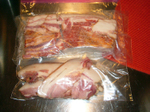 To be fair, the Seriously Good bacon guys had no idea they were entering a competition, but there was a drastic difference between the two bacons physically. Woody’s bacon was striated with fat while the Seriously Good bacon was more a fat cap next to meat. Both types possessed almost a one to one ratio of meat to fat, the Woody bacon however had its fat spread throughout, while the Seriously Good bacon was more two distinct sides.
To be fair, the Seriously Good bacon guys had no idea they were entering a competition, but there was a drastic difference between the two bacons physically. Woody’s bacon was striated with fat while the Seriously Good bacon was more a fat cap next to meat. Both types possessed almost a one to one ratio of meat to fat, the Woody bacon however had its fat spread throughout, while the Seriously Good bacon was more two distinct sides.
 We went with two methods of preparation: microwave for its exactness and lack of human error, and pan-frying, because it tastes better. Each preparation was done separately, so as not to commingle flavors. The pan-frying was performed by Pichon in two pans, the microwaving for four minutes at half power in two waves.
We went with two methods of preparation: microwave for its exactness and lack of human error, and pan-frying, because it tastes better. Each preparation was done separately, so as not to commingle flavors. The pan-frying was performed by Pichon in two pans, the microwaving for four minutes at half power in two waves.
 I don’t know how much of these results were due to cut and how much were the chestnut raising, but texture does not seem a fair point of comparison. Woody’s won hands down. The fat on the Seriously Good was just getting limber while the meat was already too tough. The Woody pig, however, benefited from its fat being distributed in striations so that crisp was crisp rather than crunchy. This carried even into the tasting – as you chewed the Seriously Good bacon the sensation was of freeing trapped salt from the limber fat, while Woody’s was uniform enough to be perceived as one thing.
I don’t know how much of these results were due to cut and how much were the chestnut raising, but texture does not seem a fair point of comparison. Woody’s won hands down. The fat on the Seriously Good was just getting limber while the meat was already too tough. The Woody pig, however, benefited from its fat being distributed in striations so that crisp was crisp rather than crunchy. This carried even into the tasting – as you chewed the Seriously Good bacon the sensation was of freeing trapped salt from the limber fat, while Woody’s was uniform enough to be perceived as one thing.
 As for flavor, in order we preferred the Woody bacon in a frying pan, the Woody bacon in the microwave, the Seriously Good bacon in the microwave, with the Seriously Good bacon in a frying pan bringing up the rear. We tried desperately not to use the word “nutty” to describe the
As for flavor, in order we preferred the Woody bacon in a frying pan, the Woody bacon in the microwave, the Seriously Good bacon in the microwave, with the Seriously Good bacon in a frying pan bringing up the rear. We tried desperately not to use the word “nutty” to describe the 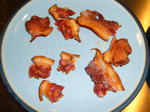 flavor of the Woody bacon. The best alternative we could come up with was when Ringwald noted its faint aromas of roasted winter squash, which did make some sense of the flavor. Sadly, as clichéd as it sounds, the fat of the nut-raised pigs was nutty, wonderfully nutty. Both bacons were salt cured, though the salt notes were far more pronounced in the harder fat of the Seriously Good bacon.
flavor of the Woody bacon. The best alternative we could come up with was when Ringwald noted its faint aromas of roasted winter squash, which did make some sense of the flavor. Sadly, as clichéd as it sounds, the fat of the nut-raised pigs was nutty, wonderfully nutty. Both bacons were salt cured, though the salt notes were far more pronounced in the harder fat of the Seriously Good bacon.
I chose Seriously Good bacon because I love it and wanted as fair a competition as possible. Going in, Pichon absolutely declared he doubted one bacon could be better, or even very different. But side by side I may have designed an unfair competition. Whether we admit it or not, bacon is about fat and the fat of nut-raised pigs just tastes better, more interesting, more complex, more pastoral and in general just more. Hands down the victor of this round was Woody’s bacon.
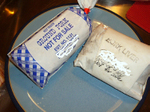 Second test-was actually an experiment. For the liver I decided we should try to recreate the sofritto Nettasdad made when we roasted the pig in October. I had tasted Nettasdad’s sofritto but was too busy with pig roasting and wine drinking to see him make it. What we had to go on was that awesome old hand Italian cook thing where he mumbled the recipe as: “the liver, the heart, some pork meat, some tomatoes, some garlic, some wine, some peppers oh yea and some peppers.” With this in mind, the gift liver seemed a fair excuse for me to test my hand at some-some-some.
Second test-was actually an experiment. For the liver I decided we should try to recreate the sofritto Nettasdad made when we roasted the pig in October. I had tasted Nettasdad’s sofritto but was too busy with pig roasting and wine drinking to see him make it. What we had to go on was that awesome old hand Italian cook thing where he mumbled the recipe as: “the liver, the heart, some pork meat, some tomatoes, some garlic, some wine, some peppers oh yea and some peppers.” With this in mind, the gift liver seemed a fair excuse for me to test my hand at some-some-some.
 We grated about four garlic cloves and set them in a cool pan with olive oil to wait while I chopped up the liver in a rough dice and mixed the ground pork in.
We grated about four garlic cloves and set them in a cool pan with olive oil to wait while I chopped up the liver in a rough dice and mixed the ground pork in.
 Once the liver was cut up and the ground pork was added to it I turned the heat under the pan to high.
Once the liver was cut up and the ground pork was added to it I turned the heat under the pan to high.
 As the garlic started to brown I added the pile of meat and spread it around evenly. I moved it a little too much, I think, because in the long run the meat more grayed then browned. (Next time I will brown the offal first, then the meat).
As the garlic started to brown I added the pile of meat and spread it around evenly. I moved it a little too much, I think, because in the long run the meat more grayed then browned. (Next time I will brown the offal first, then the meat).
Once everything was uniformly grayish brown I added some twists of salt, black pepper, and a couple shakes of chili flake.
 Then we threw a large fistful of rough-chopped vinegar peppers in and let it simmer for about fifteen minute with about four glugs from a bottle of a California Cabernet Sauvignon we were drinking (‘97 McKenzie Muller to be exact).
Then we threw a large fistful of rough-chopped vinegar peppers in and let it simmer for about fifteen minute with about four glugs from a bottle of a California Cabernet Sauvignon we were drinking (‘97 McKenzie Muller to be exact).
The first taste lacked a certain acidic zing so I added a couple more twists of salt, a couple more twists of pepper, a few more shakes of chili flake, and about a quarter cup of the vinegar from the peppers.
 Then Pichon remembered that Nettasdad had said tomatoes so we added about a half cup of chopped tomatoes and their liquid and let that cook down for another fifteen minutes. This added a different and sweeter acidity, rounding the dish out nicely.
Then Pichon remembered that Nettasdad had said tomatoes so we added about a half cup of chopped tomatoes and their liquid and let that cook down for another fifteen minutes. This added a different and sweeter acidity, rounding the dish out nicely.
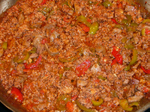 Was it as good as Nettasdad’s? Who knows? (Like I said, I was Busy drinking and roasting while he made it.) It was very good and I think I can make it better next time. I would happily serve it to friends as well as enemies as was. How much of the credit belongs to Woody’s pig meat and liver? At this point I am willing to split credit, the worst critique we got was “that’s awesome” and that was from a sober person. If I am sure of anything it is that great cooking may cover mediocre ingredients, but just as much when fooling around in the kitchen trying to reproduce someone else’s good results great ingredients will give you a huge amount of leeway which I definitely enjoyed.
Was it as good as Nettasdad’s? Who knows? (Like I said, I was Busy drinking and roasting while he made it.) It was very good and I think I can make it better next time. I would happily serve it to friends as well as enemies as was. How much of the credit belongs to Woody’s pig meat and liver? At this point I am willing to split credit, the worst critique we got was “that’s awesome” and that was from a sober person. If I am sure of anything it is that great cooking may cover mediocre ingredients, but just as much when fooling around in the kitchen trying to reproduce someone else’s good results great ingredients will give you a huge amount of leeway which I definitely enjoyed.
Third Test-For the chop I decided to take my hands out of the prep. Not many people make a pork chop so well that the New York Times reviewer dedicates the title of a review and a whole paragraph to explaining how he was close to getting it on every visit to a particular restaurant. Joey Campanaro is such a chef, so I called Little Owl to see if Joey would play along. I asked that he take my chestnut-fed Iowa chop and one of his now famous chops into his kitchen, prepare them identically, and come out and eat them with me and Pichon, not telling us which was which.
 I gave the chop to Joey wrapped hoping he would be able to mask from me which was which; sadly this could not happen. So I never saw it uncooked. On the plate, though, Woody’s was a more traditional chop and obviously different from Joey’s very thick one so I decided to turn the tables, cutting them down to bite-sized morsels and presenting them to Joey and one of his waiters blind, both of whom preferred the house chop.
I gave the chop to Joey wrapped hoping he would be able to mask from me which was which; sadly this could not happen. So I never saw it uncooked. On the plate, though, Woody’s was a more traditional chop and obviously different from Joey’s very thick one so I decided to turn the tables, cutting them down to bite-sized morsels and presenting them to Joey and one of his waiters blind, both of whom preferred the house chop.
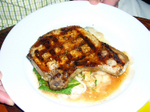 Again, this was an expected outcome. Joey, his recipe, and his chop have come together over time to be a pretty special combination and just
Again, this was an expected outcome. Joey, his recipe, and his chop have come together over time to be a pretty special combination and just 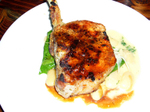 throwing Woody’s chop in deprived it a fair evolution. There is no doubt, though, that Chef Campanaro was fair in the kitchen; both chops were the same hue of pink in the middle, the Woody chop a little more succulent and the Joey chop toothier, apparently by nature.
throwing Woody’s chop in deprived it a fair evolution. There is no doubt, though, that Chef Campanaro was fair in the kitchen; both chops were the same hue of pink in the middle, the Woody chop a little more succulent and the Joey chop toothier, apparently by nature.
Once the four of us had tasted, the consensus seemed to be:
-- that the fat on the Woody chop scorched on the grill, giving it an acrid note. We figure that this cut may be better suited to roasting or some other longer, lower heat aplication.
-- that the fat in the Woody chop really adopted the fennel and black pepper notes of Joey’s marinade, so much that some bites were a little overpowering, and that the aroma of these lingered far longer with the Woody chop.
So what have we learned? First and foremost, it may be bad to accept candy from strangers, but pork should always be welcome. Second, that a diet of nuts makes for far more interesting pork. I don’t know what it will take for Woody to move from the fooling-around-raising-pigs-on-the-nuts-left-over-after-the-humans-are-taken-care-of phase to the pig-raising phase, but I hope it happens soon. This meat was amazing, seriously reminiscent of the greatest pigs I have had.
04:11 PM in rants, recipe, the best | Permalink | Comments (1)
October 25, 2006
Michelin Guide NYC '07 (those silly French II)
One small post changed me from a guy at the end of the bar ranting about wine, restaurants, and food politics, to a guy on a computer ranting about wine, restaurants, and food politics. That post was entitled Those Silly French and was written in response to friends asking for my opinion on the first Michelin guide to New York. Well another group of stars has been awarded and again my computer lit up with people asking my thoughts.
First, let me start with a conspiracy theory about industrial culture because these are the things that make my world go round:
If I were involved in the world’s largest tire company, when I met with my local government to discuss things like tax credits and pensions (as I understand it France is very involved in these areas with French-based companies) I would find it an advantage to be able to make the case that for seventy-five years I have worked to promote travel to France. I would also like to be able to point out that what started as a little book to encourage Frenchmen to wear out their tires driving all over the country in the summer travel season, successful due to its reputation for integrity, has turned into a reason people come to France to spend food dollars at an unrivaled rate. If this were one of my bargaining chips, which it assuredly would be, as the guide grew in popularity and became a viable business I would grow it carefully ever mindful that, to the end of remaining a bargaining tool for my actual business (tires), it would need to remain a significant motivator of the belief that fine food is available more in France than anywhere else.
I think Michelin is producing a French guidebook trying to establish itself in foreign markets, and I think part of this motivation may simply be to lend credibility to the French guide. When the whole world is saying there are almost a dozen restaurants in Spain operating at a level beyond all but a few places in France, what better way to quell these worries and keep your credibility than to acknowledge the irrefutable successes with some stars? And if the people start insisting that New York and other major US cities have as many great places as Paris while Parisian chefs are turning their backs on your ratings, what better way to keep your hold as the definitive voice on fine dining than to start a New York book?
Ok, that’s out of my system. Going forward let’s assume Michelin is just trying to grow a successful business. The perceived integrity referred to in the conspiracy above was based on a couple of simple truths that have been seeing some rocky times as of late. Some assumptions regarding Michelin’s ratings have proven to be false in recent years, such as that there was a huge anonymous staff traveling the world of dining, ever on the quest for places worth traveling to, or that Michelin inspectors had actually visited all the places reviewed. Then there were the rules that applied almost without exception, which I thought mattered most. Rules like that all restaurants must start at a base one star level and that only after multiple visits and time proving they could perform at the top level could they be advanced, which meant that if you were a three star Michelin restaurant you had achieved at a top level for many years with many and constant inspections.
Starting a New York book with any three star restaurants, let alone including one that was in its first two years of existence, belied any integrity claimed. This simple move more than any other proved that Michelin did not hold this book or this place to the same level that it holds its French books and restaurants, implying that the folks there don’t see equal merit in our food (unless of course they were giving additional credence and merit to some restaurants simply for being French, which also implies a lack of understanding of American cuisine).
Then there is their choice to do a New York guide (and this year one for San Francisco) and not a US one. Keeping in mind that Michelin is meant to be a travel guide about restaurants, there are at least five restaurants in Chicago I do travel for solely and regularly. Based simply on reputation, there are another ten in California I plan to travel for (when I do visit you can be sure I will let you know if I found them worth the trip). There are also two places in Boston I travel for, one in DC (and another two I would like to). There is at least one place in every major city that is worth a diversion to for a meal. Here we bump into my conspiracy again: if you properly try to assess the restaurants of America and not isolate them by city but simply apply the criteria of destination eating to the nation, towns like Philly alone should get a star each for its cheese-steak places (if you are there you should definitely try one at either Pat’s, Gino’s or Carl’s), not to mention at least two (I would say three Michelin stars are deserved) for Le Bec Fin. Fairly analyzing a region even as small as the original thirteen colonies would blow out the bloated count for France by comparison, which would be dangerous to the service Michelin provides of keeping people traveling to France above all other countries for destination dining.
So what do I think of the current list for New York? Well you are still reading so:
As I understand it the meaning of the stars is:
One: if you are in this city this is a very good place well worth visiting
Two: if you are near this city go to this place
Three: this place is so good it is worth traveling to that city simply for the experience of dining at
Applying this notion of the stars here are my thoughts
THREE STARS
Jean Georges: I would travel for this place and happily add the cost of travel to my dinner.
Le Bernardin: still haven’t traveled from the Village to try it.
Per Se: went, was let down and have not forgiven; one of the reasons I find it hard to cross 23rd Street.
TWO STARS
Bouley: very good, when I am already in its neighborhood visiting friends I happily go.
Daniel: I would travel from the Village.
Del Posto: good or bad it is a unique experience worth traveling to at least once.
Masa: hands down the greatest single meal I have had was here, but it is such a destination place sometimes I wish I lived far away so I would be forced to seek it out more.
ONE STAR
Annisa: no idea.
Aureole: they have wine fairies in Vegas right? That has always kept me from taking it seriously.
A Voce: travel to get fleeced by a wine list? yeah, right.
Babbo: goes without saying that people travel for this place; sooner or later people on their way to New York ask me for any secrets I might know about getting a res, especially those who have been already.
Café Boulud: I would cross neighborhood boundaries for this place.
Café Gray: still haven’t traveled past the other places in the mall for it, but haven’t given up.
Country Restaurant: had a bad time at the bar early and haven’t traveled past that.
Craft: makes no sense to me to go back to a place that puts the job of the chef on the diner, but this is New York and people like control so if that’s what you’re into it may be worth a stop when you are traveling to a dungeon or some other place that puts all the decisions on you.
Cru: I find it hard to believe there are many better meals to be had in New York than I have had at Cru so I travel there regularly, in fact I often go there first when on my way back from traveling.
Danube: haven’t been, know I should but it involves traveling past places I love.
Dévi: I really like Devi and have traveled at least eight blocks to eat there.
Etats-Unis: isn’t that on the Upper East Side, pretty much would rather go to Chicago.
Fiamma Osteria: it’s good.
Fleur de Sel: I love not having to travel much to go to this place, the Monday night wine deal may be worth commuter airfare, though.
Gotham Bar & Grill: I can think of few more definitively organically born of New York places, so I guess if that’s what you want it is well worth the travel.
Gramercy Tavern: People very often travel from far away to join me for meals here.
Jewel Bako: can’t travel past Degustation.
Kurumazushi: news of it has yet to travel to me.
La Goulue: got to look into this one.
Lever House: no idea.
Modern (The): no travel, no thanks.
Oceana: great meal but have never seen cause to travel back.
Perry Street: well I love spending food dollars at JGV so hard to say.
Peter Luger: travel to Brooklyn for a steak that variant in quality? Sure, as long as it is with a big group of people so excited by the travel they never seem to notice.
Picholine: as long as our USDA rules remain as they are for fresh cheese and hunted game it will be worth travel from all over.
Saul: if they ever do Michelin Brooklyn I may make a journey there to hit a couple places.
Spotted Pig: stopped traveling there early on; nice food but this is New York, pubs with good grub are easy to come by.
Sushi of Gari: heard great stuff, not enough to travel that far yet.
Veritas: you love wine, especially Parker wines? May be better spent travel dollars than Napa or Bordeaux.
Vong: not in a long time.
Wallsé: involves traveling past places I know to be cool, but its on my list.
wd~50: few people in the world with an opinion don’t agree that Wylie is pretty serious among those changing the face of world dining. You tell me, is that worth traveling for?
Without going too deep into the list I will simply mention three places unique to New York that I believe should be experienced by all, are worth traveling for, and could only exist here: Blue Hill, Savoy, and Hearth.
So I guess on their second attempt rather than seeming crazy the folks at Michelin just seem not to understand New York. Then again, if your goal is to understand New York, would you look to the French for advice in the first place?
10:02 AM in rants | Permalink | Comments (4)
October 16, 2006
Green Market
…I don’t know if I am in a new restaurant rut or the city is, but when I think about eating these days the newer options all seem to be a new burger joint, a new steak house, or some ridiculous theme spot, none of which play nicely into my ideal of a place with integrity of vision, execution, ingredient and a sense of community.
In times like this I tend to do one of two things: revisit my most favorite restaurants, and cook at home. On the revisiting front I happily declare that Cru, Lupa, Hearth, Blue Hill, Gotham and Morimoto are all still wonderful assets to our community. As for cooking at home, even though or maybe because this was one of the worst tomato seasons ever, I have been loving different things from the greenmarket that I would be happy to tell you about.
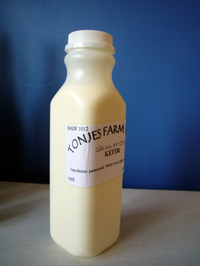 First and foremost is the kefir from Tonjes Farm Dairy. People from Eastern Europe will tell you great stories about kefir making you live forever because of its active cultures. I like it because in good versions it combines a very sour lactic yogurt flavor with a very earthy pastoral flavor, and this is a very good version. I have not learned the entire story from the Tonjes folks yet; for most of this summer they were just the guys next to Tim Stark’s stand selling very good Mozzarella I was buying to go with Tim’s tomatoes before the season washed out. Then about four weeks ago I saw kefir listed on the Tonjes’ sign and bought a bottle (having gotten fed up with not being able to find a pedigree for the Organic Lifeway kefir I had been buying from Fresh Direct which the Cornucopia Institute has rated as “ethically challenged” for producing or purchasing factory farm milk, I needed a new source). Since then I have probably had about thirty small bottles of it, and cannot only tell you I love it, I can say that I like it best around the Wednesday or Thursday after my Saturday purchase.
First and foremost is the kefir from Tonjes Farm Dairy. People from Eastern Europe will tell you great stories about kefir making you live forever because of its active cultures. I like it because in good versions it combines a very sour lactic yogurt flavor with a very earthy pastoral flavor, and this is a very good version. I have not learned the entire story from the Tonjes folks yet; for most of this summer they were just the guys next to Tim Stark’s stand selling very good Mozzarella I was buying to go with Tim’s tomatoes before the season washed out. Then about four weeks ago I saw kefir listed on the Tonjes’ sign and bought a bottle (having gotten fed up with not being able to find a pedigree for the Organic Lifeway kefir I had been buying from Fresh Direct which the Cornucopia Institute has rated as “ethically challenged” for producing or purchasing factory farm milk, I needed a new source). Since then I have probably had about thirty small bottles of it, and cannot only tell you I love it, I can say that I like it best around the Wednesday or Thursday after my Saturday purchase.
 Keith’s mesclun greens are the next awesome available ingredient. All kinds of greens – bitter, spicy, sweet, soft, fibrous – all triple-washed and sold loose at what seems a very fair price. I have been simply throwing these in a bowl and dressing them with a drizzle of Olio Verde, a pinch of Maldon salt, and a sprinkling of the grated aged Goat cheese
Keith’s mesclun greens are the next awesome available ingredient. All kinds of greens – bitter, spicy, sweet, soft, fibrous – all triple-washed and sold loose at what seems a very fair price. I have been simply throwing these in a bowl and dressing them with a drizzle of Olio Verde, a pinch of Maldon salt, and a sprinkling of the grated aged Goat cheese 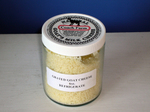 Coach farms sells in jars. At this point I think I am taking down about a pound and a half of these greens a week and looking forward to more tonight.
Coach farms sells in jars. At this point I think I am taking down about a pound and a half of these greens a week and looking forward to more tonight.
There are many other things going on as well. Thanks to Meg I tried Flying Pigs’ liverwurst when I picked up my usual bacon and eggs. I sliced it and put it on toasted Rye from Rock Hill Bakehouse with some coarse mustard and sliced onions (Keith’s Farm again). I am averaging a steak of some cut or other a week from Hawthorne Valley Farms as well as their pickles for snacking.
Except for tomatoes it was been quite a harvest this year, and everything tastes wonderful but, sadly, years of wandering the Greenmarket has officially set the end date in my calendar as Thanksgiving, so get there and eat, or at least don’t say I didn’t warn ya...
09:54 AM in rants | Permalink | Comments (3)
October 10, 2006
PIG: rotisserie, charcoal, wet rub
Pichon, Helmet, Link and me standing outside a red barn-like butcher shop at the end of a dead end road in Chatham Township, NJ, on a chilly early autumn morning with a sixty-seven pound pig on a stick and four bags of charcoal, discussing constant rotation or focused heat with a man in a bloodied white jacket is the picture of this day. 
The first plan was to cook a proper ghetto pig. One day I happened across Link and Helmet talking about pig cooking methods and joined the conversation. They were discussing whether to bury it with coal and banana leaves, or to roast it rotisserie style. I told the story of when I first got involved in pig roasting through Cuz, and that the research he had done had turned up a website by a couple of Cubans in Miami who like to butterfly a whole pig, strap it to a chain link fence and grill it, something I had always wanted to try. At this point Cuz and I have rotisseried many pigs and have strong beliefs on the proper way to do it, but I have always thought it would be fun to do the ghetto pig version of the guys down in Miami. So Helmet, Link and I started discussing approaches and methods and decided the pig would be done lashed to fencing and set on cinderblocks over charcoal.
About the time we figured out that un-galvanized aluminum fencing is almost impossible to get in the metropolitan New York area (I assume the weather changes of the northeast make it impractical to use unprotected steel, or aluminum) Helmet found this butcher in NJ that rents fire pits and rotisseries and gives you the entire pig already lashed to the spit. 
The story as we believed it was that this place was a working farm and we would be involved in the killing of the pig, something I felt obliged to participate in because of the amount of trepidation it caused me. As it turned out, after having steeled myself to face the discomfort of taking part in an intimate task of involving myself in the moment of death of my food that society has so removed us from it seems foreign, I had actually taken an extra step away from being involved because the second most intimate thing about roasting a whole pig is the actual hands-on step of securing the beast to the spit and the folks of Green Village Packing, had already done this for us. 
So we gave up a little involvement in the interest of convenience, which tears me. I hate convenience in food prep as a general principal. Wife and I long ago threw out our microwave believing that the little extra time taken in making things like mashed potatoes from scratch makes a far bigger difference in flavor. However, when preparing food for fifty folks, a little help is great. 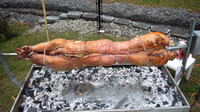
When Cuz and I roast a pig we have come to a pretty stripped down method. We simply and liberally salt the inside of the carcass and fasten it on the rod. We then salt it again on the outside, and set it over the heat. Now, to be honest, leaving well enough alone is the hardest part from here on out. In order to give ourselves something to do, we’ve picked up the little nervous device of dipping long branches of rosemary in olive oil and smacking them against the skin of the pig while it cooks. I know that the skin of a pig is tough enough to make footballs from so I don’t believe we are doing any flavor adding with our little exercise, but it is still fun and dissipates the energy of hours of staring.
What the folks at Green Village Packing do besides giving you the fire pit, the charcoal, the rotisserie, and the spit, as well as affixing the pig, is to season its interior. They use a blend of garlic, herbs, adobo, black pepper and oil, all good and all sensible and all much appreciated. I clearly am a purist and find the flavor of slow-roasted pork best unadorned while cooking. I do like accoutrements like mojo, or vinegary slaw, or even hot barbeque sauce when it is done, but for cooking I keep it simple. That being said, nothing could be simpler than this. 
Literally all you have to do is go home, light a fire, set the spit in the rotisserie and cook until the ham and shoulder achieve 165 degrees in the center. And that’s almost what we did. My belief is the pig should be belly side down over low heat for about 45% of the estimated cooking time (about an hour for every 10-12 pounds). Then 20% on each side, 10% with the back facing down, and the remaining 5% spent spinning over much higher heat to crisp and brown the skin. The logic here is that the concentration of the meat is on the pig’s underside, so time spent spinning it leaves ¾ of each minute with the densest concentration of the meat being off the flame, making the leaner meat toward the pigs back overcook. So without a calculator I guessed our sixty-seven pound pig would spend two and a half hours stomach down, an hour or so on its left side followed by another hour or so on its right, half an hour with its feet in the air, and the remaining time spinning with periodic temperature checks.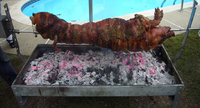
The reality is, as will always happen when men gather around a fire with raw meat, a committee formed with votes on how best to do it. Ultimately, we went with one hour belly down, one hour spinning, half an hour on each side (while a rosemary, garlic olive oil wet rub was applied to the off-fire side) and then spinning till it was finished (people like to watch things spin). There is also the truth that meat + fire = happy eaters.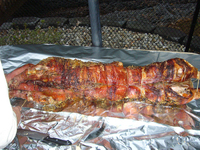
About 90% of the pig was consumed within half an hour of it coming off the spit. I was proud to have been a part of it’s making (even though the back was a little tougher then I like ;-) and, as often happens when I cook, I had little interest in eating it beyond the taste that confirmed I was proud of the job we had done. Instead, I went inside to eat the sofritto that Nettasdad had made of our pig’s heart and liver. Now that’s the way food should taste; once I figure out how to make it I’ll tell ya. 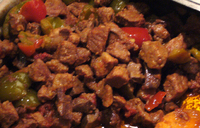
06:25 PM in day drinking, friendly spirits, rants, recipe | Permalink | Comments (1)
September 29, 2006
Thoughts week ending 9/29/06
…Bill Buford’s New Yorker article about the Food Network started me wondering about things you don’t see on the Food Network any more other than chefs and dirt, like foie gras. How can a channel about food not show Foie Gras? I have to assume it stems from some ridiculous “don’t upset anyone, anywhere” approach to marketing. Add this to the list of reasons I no longer watch the Food Network. Does anyone else miss Discovery’s “Great Chefs” and Emeril before the audience???
…I just assume everyone that comes to Augieland clicks on that link to the Bruni Digest while visiting. If not, do so today. She is a very funny woman…
…Ok, clearly the whole world has gone insane. Mark it on your calendar: we are officially doomed as a race as of 9/27/06 and the exact thing to mark this event is this article by Marion Burros in the Times entitled “Tainted Spinach Brings Demands for New Rules.”
At this point we are all aware that somehow in the last month or so spinach caught a cold named E. coli O157:H7 and started giving it to humans. This particular strain is dangerous to humans and our best guess at the moment is that it got to the spinach through run-off water from factory cattle farms near the spinach fields.
Now here is where the insanity starts. You ready for this??? Brace yourself… the proposed issue and solution, from a microbiologist at UC Davis named Dr. Trevor Suslow is, get this, “Should cows be raised in close proximity to produce? Ideally, you would like to see them well separated.” And the FDA has this to offer, “I’m speculating, but there is a logical link between cattle and manure getting into the water.” Can you smack a whole government department for being stupid?
So rather than stop creating the poison by ending the practice of feeding cows poison (yes corn is poisonous to cows) even though E. coli and all the other poisons current cattle farming practices create obviously will find ways into our lives no matter where we put the feedlots (it is spread through the water table), we will separate spinach and cows as if it were insane to assume animals and vegetables could coexist and that we have just been dodging a bullet for the thousands of years we have luckily gotten away with these crazy death-traps called farms.
Here is the solution I offer free of charge: STOP POISONING YOUR FOOD. How? The simple fact that the idea being put forth as problematic is that farm animals and farm vegetables need be separated makes it pretty clear the corn subsidies that are actually the root of this poisoning will not be ended. So what’s left? Avoid buying standard beef in the supermarket, restaurants or fast-food chains as much as possible. No kidding. Make steak a special thing, pay a little more for grass-fed beef raised on pasture, and enjoy it, it actually tastes far better. Tell your restaurants why you are eating less, they will get you what you want.
The ultimate irony is that if we fed all the tainted spinach we are throwing out to the cows rather than what we are currently feeding them the E. coli issue would probably clear up…
…So in the middle of an E. coli issue clearly tied to spinach four kids who regularly drink raw milk get E. coli and the milk is blamed and a recall enacted. Well the milk has been tested and proven not to have E. coli. Yet the recall stands. We all know where I stand on raw milk, and it is hard to talk about this without sounding like a strange paranoid conspiracy theorist. But here is an example of the result of years of demonization of raw milk by an industry that only stays hugely profitable if pasteurization stays the status quo. During a spinach-related E. coli outbreak in the part of the world the spinach is from, raw milk is the first assumed infector…
…I saw a post on The Gurgling Cod I felt inspired to comment on about snapping pictures in restaurants, which in turn led me to this article by Molly O’Neill in The Columbia Journalism Review, which I very much enjoyed because of writing like this:
From the beginning of newspaper food coverage, the pages have been home to dietary fads and weight-loss schemes. Horace Greeley was himself an acolyte of Sylvester Graham, whose vegetarian moralism makes that of say, Dr. Dean Ornish, appear to be downright sybaritic. But it may be nothing more than the mists of time that differentiate the dietary faddism of that era from the fads promulgated by food writers today. After being diagnosed with hypertension and counseled to reduce his salt intake, for instance, Claiborne wrote a guide to cooking without salt called Craig Claiborne's Gourmet Diet in 1980. Based on the medical establishment's assumption that foreswearing salt could stave off hypertension, Claiborne echoed the American Heart Association's position and rallied the public to join his low-salt life-style. Thus was a low-salt food industry born before further research revealed that although cutting salt consumption is critical for people who have high blood pressure, reducing it prior to the onset of high blood pressure generally does little to lower the chance of developing the disease.
Interesting, no???
...What good is lamenting the scourge of factory farms and sick cows without offering a viable and accessible alternative?
Wife and I have been heartily enjoying our weekly CSA vegetables from Stoneledge Farms and, saddened that our summers’ share will soon be drawing to a close, were delighted to learn that the Washington Square CSA will be offering a winter share this year consisting of winter vegetables, organic chicken, grass-fed beef, organic eggs and dairy products and assorted dry goods (beans, granola and the like) from local farms. Unlike our summer share, this will be a once-monthly pick-up and runs from December through April. We are looking forward to seeing what the winter brings…
01:27 PM in Current Affairs, rants | Permalink | Comments (4)
September 15, 2006

Recent Posts
- check this out http://www.tworivertimes.com/issues/110819/news5.php
- so check this out: www.cartonbrewing.com
- per se again
- Nutshelling Momofuku Ko & Terroir
- Adour Alain Ducasse 262 Henningillian stars
- Inn At Little Washington 652 Relaisiilian stars
- Bleecker Street Pizza, 840 Canorajillian stars
- L'Impero 543 modernoillian stars
- The Inn Lw12, 762 gueuledeboisillian stars
August 2011
| Sun | Mon | Tue | Wed | Thu | Fri | Sat |
|---|---|---|---|---|---|---|
| 1 | 2 | 3 | 4 | 5 | 6 | |
| 7 | 8 | 9 | 10 | 11 | 12 | 13 |
| 14 | 15 | 16 | 17 | 18 | 19 | 20 |
| 21 | 22 | 23 | 24 | 25 | 26 | 27 |
| 28 | 29 | 30 | 31 |
Recent Comments